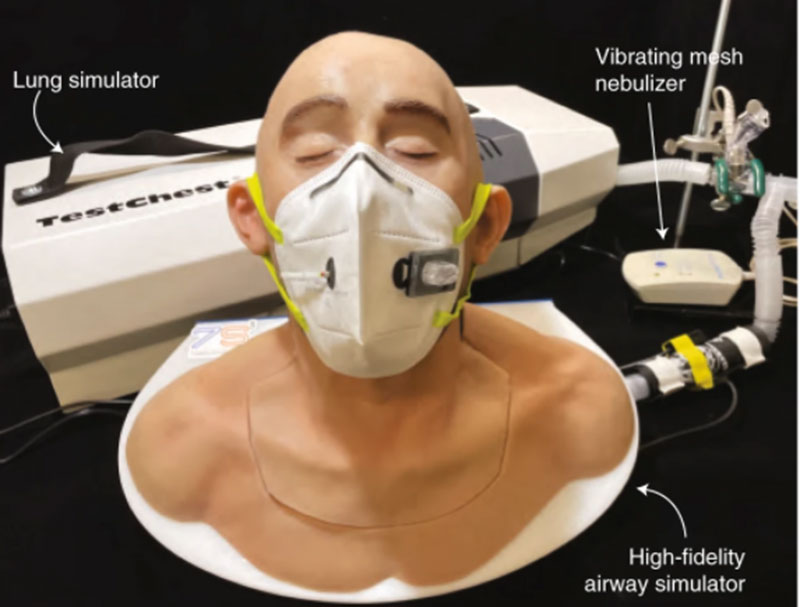Integrating synthetic biology into wearables could expand opportunities for noninvasive monitoring of physiological status, disease states and exposure to pathogens or toxins. However, the operation of synthetic circuits generally requires the presence of living, engineered bacteria, which has limited their application in wearables.
Read more LG Launches PuriCare, A Rechargeable Wearable Air Purifier Mask
An international team of researchers from Wyss Institute, Harvard, MIT, and DREAMLUX, Samsara S.r.l., Italy, have developed a face mask with a lyophilized CRISPR sensor for wearable, noninvasive detection of Coronavirus (SARS-CoV-2) at room temperature within 90 min. The technology requires no user intervention other than the press of a button.
The researchers used lightweight, flexible substrates and textiles functionalized with freeze-dried, cell-free synthetic circuits, including CRISPR-based tools, that detect metabolites, chemicals and pathogen nucleic acid signatures. The wearable devices are activated upon rehydration from aqueous exposure events and report the presence of specific molecular targets by colorimetric changes or via an optical fiber network that detects fluorescent and luminescent outputs. “The detection limits for nucleic acids rival current laboratory methods such as quantitative PCR. We demonstrate the development of a face mask with a lyophilized CRISPR sensor for wearable, noninvasive detection of Coronavirus at room temperature within 90 min, requiring no user intervention other than the press of a button,” the researchers wrote.
Colorimetric wFDCF wearables
For their first wearable freeze-dried cell-free (wFDCF) demonstration, the team embedded colorimetric genetic circuits into cellulose substrates surrounded by a fluid wicking and containment assembly made of flexible elastomers. These prototypes were assembled layer-by-layer to form reaction chambers fluidically connected to top sample portals. The devices are flexible, elastic and can rapidly wick in splashed fluids through capillary action.
The fluorescent wFDCF platform allows for continuous monitoring of all reaction chambers through the fiber optic network at user-defined sampling intervals for the automated detection of rehydration events and fluorescent outputs from target-activated circuits.
The researchers used Cas13a and Cas12a for the detection of RNA and DNA, respectively.
For real-time monitoring of environmental exposure and biohazard detection, the team designed a jacket containing a distributed arrangement of wFDCF multi-sensor arrays. The various optical fibers carrying the output emission signals from different sensors can be routed into a single bundle for centralized imaging analysis, which we demonstrate using a wFDCF CRISPR–Cas12a-based MRSA-sensing array, containing spa, ermA and mecA sensors, that was activated in the wearable prototype with a fluid splash containing 100 fM of spa DNA trigger.

A face-mask-integrated sensor for SARS-CoV-2 detection in exhaled aerosols
Finally, the researchers explored whether their wFDCF system could be adapted to create face masks capable of detecting SARS-CoV-2, as a complementary approach to diagnosis based on nasopharyngeal sampling. Respiratory droplets and aerosols are the transmission routes for respiratory infectious diseases but have been underutilized historically for diagnosis. Work on breath-based sensing has focused on the detection of volatile organic compound biomarkers in infected patients using electrochemical sensors or downstream mass spectrometry analysis, which may be challenging to implement on a wide scale. The National Institutes of Health Rapid Acceleration of Diagnostics Initiative has identified SARS-CoV-2 detection from breath sampling technologies as an active area of interest for alleviating testing bottlenecks.
The virus accumulates on the inside of masks as a result of coughing, talking or normal respiration. The researchers designed a face-mask sensor containing four modular components: a reservoir for hydration, a large surface area collection sample pad, a wax-patterned µPAD (microfluidic paper-based analytical device) and a lateral flow assay (LFA) strip.
From activation of the face-mask sensor to a final readout only takes about 90 minutes. The limit of detection observed for these sensors is 500 copies (17 aM) of SARS-CoV-2 in vitro transcribed (IVT) RNA, which matches that of World Health Organization-endorsed standard laboratory-based RT–PCR assays.
The researchers say that potential applications for their wFDCF sensors include warfighters and first responders operating in environments where a specific chemical or biological threat is suspected, and clinicians, health workers and researchers working in high-risk areas. For example, wFDCF-enabled coats and gowns in hospitals could provide alerts to prevent the spread of nosocomial infections. An additional promising application is patient-worn, sensor-enabled personal protective equipment, such as the SARS-CoV-2 face mask.
Read more Graphene Facemask Kills Bacteria and Showed Potential In Deactivating Coronavirus
Researchers involved in this study were Peter Q. Nguyen, Luis R. Soenksen, Nina M. Donghia, Nicolaas M. Angenent-Mari, Helena de Puig, Ally Huang, Rose Lee, Shimyn Slomovic, Tommaso Galbersanini, Geoffrey Lansberry, Hani M. Sallum, Evan M. Zhao, James B. Niemi & James J. Collins
The study was published in Nature Biotechnology.












